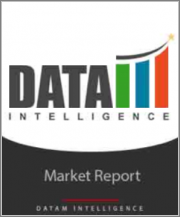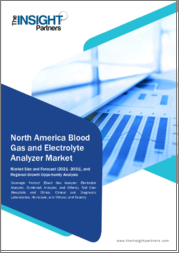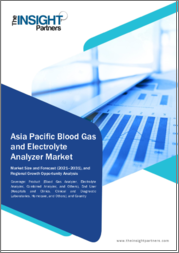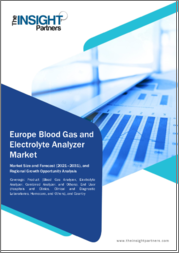
|
시장보고서
상품코드
1374824
세계의 혈액 가스 및 전해질 분석기 시장(2023-2030년)Global Blood Gas and Electrolyte Analyzers Market -2023-2030 |
||||||
개요
혈액 가스 분석기는 주사기로 혈액을 흡입하여 pH와 산소 분압, 이산화탄소 분압을 측정합니다. 중탄산 농도도 계산됩니다. 이 결과는 보통 5분 이내에 해석할 수 있습니다.
전해질 분석기는 생체 시료(일반적으로 혈액 또는 혈청)의 전해질 농도를 측정하기 위해 고안된 특수 의료기기입니다. 전해질은 나트륨(Na), 칼륨(K), 염화물(Cl-), 중탄산염(HCO3-), 칼슘(Ca2)과 같은 필수 이온을 의미하며, 인체의 다양한 생리적 과정에서 중요한 역할을 합니다. 이러한 전해질 수준의 정확한 측정은 다양한 병의 진단과 관리에 필수적입니다.
시장 역학: 시장 촉진요인과 시장 억제요인
기술 발전의 부상
응급의료 및 응급의료 현장에서는 환자의 생리적 상태가 빠르게 변화하고 빠르게 악화될 수 있기 때문에 환자의 예후를 개선하기 위해 신속한 진단과 임상적 판단이 필요합니다. 현장 검사(POCT)는 분산된 환자 중심 의료 서비스를 제공하기 위해 고안된 중환자 치료 환경의 중요한 발전입니다. 혈액 측정, 특히 혈액 가스 및 전해질에 대한 신속한 접근은 임상 결과를 개선할 수 있습니다.
예를 들어, 2023년 6월, B&E Biotechnology(중국 연태)의 i-Check 휴대용 혈액 가스 전해질 분석기는 마이크로 유체 기술과 전기화학 검출 기술을 채택했습니다. 일회용 카트리지에는 플라스틱 기판, 다중 바이오 센서 어레이, 교정기 파우치, 샘플 주입 포트 및 폐액 챔버가 포함되어 있습니다. 주목할 만한 점은 멀티 바이오센서 어레이가 실크스크린 인쇄로 제작되었다는 점입니다. 사용되는 인쇄 잉크 재료는 귀금속을 전혀 사용하지 않고 탄소, 은, 절연체로만 구성되어 있어 다른 제조업체에 비해 생산 비용을 크게 낮출 수 있습니다.
또한, 암 및 당뇨병과 같은 만성 질환 치료를 위한 의료비 지출 증가는 예측 기간 동안 시장 성장을 촉진할 것으로 예상됩니다. 이러한 증가는 중환자실과 응급실의 환자 수 증가로 이어져 혈액 가스 및 전해질 분석에 대한 수요 증가로 이어지고 있습니다. 관련 기관과 정부는 환자가 정기적인 진단 검사를 받도록 장려함으로써 의료비 지출을 줄이기 위한 프로그램을 지속적으로 시행하고 있습니다.
시장 역학: 시장 억제요인
고전적인 혈액 가스 분석은 동맥혈 샘플이 필요하기 때문에 샘플을 채취할 때 많은 문제가 발생합니다. 예를 들어, 시료에 외부 공기가 섞이는 것을 피하기 위해 특수 가스 주사기를 사용합니다. 또한 혈액 샘플은 채취 후 즉시 적절하게 혼합해야 하며, 그렇지 않으면 침전이 발생하여 불균일한 샘플이 될 수 있습니다.
또한, 숙련된 전문가 부족, 분석 장비 비용, 상환 문제, 복잡한 규제 등이 시장의 주요 저해요인으로 작용하고 있습니다.
이 보고서의 자세한 내용 - 샘플 요청
목차
제1장 조사 방법과 조사 범위
제2장 정의와 개요
제3장 주요 요약
제4장 시장 역학
- 영향요인
- 성장 촉진요인
- 테크놀러지 진보
- 만성질환 증가
- 성장 억제요인
- 샘플 채취에 따른 과제
- 기회
- 영향 분석
- 성장 촉진요인
제5장 산업 분석
- Porter's Five Forces 분석
- 공급망 분석
- 가격 분석
- 규제 분석
- 러시아·우크라이나 전쟁의 영향 분석
- DMI 의견
제6장 COVID-19 분석
제7장 제품 유형별
- 혈액가스 분석기
- 전해질 분석기
- 복합 분석기
- 기타
제8장 모달리티별
- 탁상형
- 휴대용
제9장 최종사용자별
- 병원
- 중앙 검사실
- POC(Point of Care)
- 기타
제10장 지역별
- 북미
- 미국
- 캐나다
- 멕시코
- 유럽
- 독일
- 영국
- 프랑스
- 이탈리아
- 스페인
- 기타 유럽
- 남미
- 브라질
- 아르헨티나
- 기타 남미
- 아시아태평양
- 중국
- 인도
- 일본
- 호주
- 기타 아시아태평양
- 중동 및 아프리카
제11장 경쟁 상황
- 경쟁 시나리오
- 시장 상황/점유율 분석
- M&A 분석
제12장 기업 개요
- Abbott Point of Care Inc
- 기업 개요
- 제품 포트폴리오와 설명
- 재무 개요
- 주요 발전
- Siemens Healthcare Private Limited
- Cornley Hi-tech Co., LTD
- Radiometer Medical ApS
- Chengdu Seamaty Technology Co., Ltd
- EDAN Instruments, Inc
- ERBA Diagnostics Mannheim GmbH
- F Hoffman La Roche Ltd
- Medica Corporation
- i-SENS, Inc
제13장 부록
ksm 23.11.16Overview
Blood gas analyzers aspirate blood from the syringe and measure pH and the partial pressures of oxygen and carbon dioxide. The bicarbonate concentration is also calculated. These results are usually available for interpretation within five minutes.
An electrolyte analyzer is a specialized medical device designed to measure the concentration of electrolytes in a biological sample, typically blood or serum. Electrolytes are essential ions, including sodium (Na + ), potassium (K + ), chloride (Cl-), bicarbonate (HCO3-), and calcium (Ca2 + ), that play crucial roles in various physiological processes within the human body. The accurate measurement of these electrolyte levels is vital for diagnosing and managing a wide range of medical conditions.
Market Dynamics: Drivers and Restraints
Rise in technological advancements
A vital factor for patients in emergency and critical care settings is their rapidly changing physiological state, which can deteriorate quickly and necessitate immediate diagnosis and clinical decisions for improving patient outcomes. Point-of-care testing (POCT) is a significant advancement in critical care settings, designed to provide decentralized, patient-centred healthcare. Quick access to blood measurements, especially blood gases, and electrolytes, can lead to better clinical outcomes.
For instance, in June 2023, i-Check handheld blood gas electrolyte analyzer from B&E Biotechnology Co. Ltd. (Yantai, China) adopted microfluidic and electrochemical detection technology. Its single-use cartridge includes a plastic substrate, a multi-biosensor array, a calibrator pouch, a sample injection port, and a waste chamber. Notably, the multi-biosensor array is produced by silk-screen printing. The printing ink materials used comprise only carbon, silver, and insulation, without any noble metal, which significantly lowers the production cost compared to other manufacturers.
Furthermore, increasing healthcare expenditure for the treatment of chronic diseases, such as cancer and diabetes, is expected to drive market growth over the forecast period. This increase indicates a rise in the number of patients in critical care units and emergency departments, which has led to the growing need for blood gas and electrolyte analysis. Pertinent organizations and governments are constantly engaging in programs to reduce healthcare expenditure by encouraging patients to undergo regular diagnostic examinations.
Market Dynamics: Restraint
Since classical blood gas analysis requires an arterial blood sample, many challenges arise during sample collection. For example, special gas-tight syringes are used to avoid adulteration of the sample with outside air. Furthermore, the blood sample must be properly mixed immediately after collection, otherwise, sedimentation will occur, resulting in an inhomogeneous sample.
Also, some of the major restraining factors in the market include the lack of skilled professionals, the cost of the analyzer, reimbursement issues, and complicated regulations.
For more details on this report - Request for Sample
Segment Analysis
The global blood gas and electrolyte analyzers is segmented based on product type, modality, end-user and region.
The blood gas analyzers from the product type segment accounted for approximately 41.2% of the market share
The blood gas analyzers from the product type segment accounted for 41.2% and it is expected to be dominated during the forecast period. Blood gas analyzers are used to measure combinations of pH, blood gas (i.e. pCO2 and pO2), electrolytes, and metabolite parameters from whole blood samples. Blood conservation is an important initiative in every clinical diagnostic lab or critical care facility. Therefore, a highly accurate blood gas analyzer can streamline work processes and reduce errors with minimum maintenance.
For instance, in June 2022, Sysmex America Inc., a leading name in the diagnostics solutions marketplace, received FDA clearance for the addition of a new feature to its N-10 Automated Hematology Analyzer with Blood Bank mode. This is the first automated analyzer to be cleared for residual WBC counting.
Moreover, in April 2021, Siemens Healthiness launched the epoc blood analysis system, It is a handheld, wireless solution with complete blood gas, a basic metabolic panel, and hematocrit and lactate on a single room temperature-stable test card, delivering patient-side results in less than 1 minute. It aids in supporting COVID-19 response efforts, where blood gas testing plays a critical role in managing infected patients.
Geographical Analysis
North America accounted for approximately 38.4% of the market share in 2022
North America is estimated to hold about 38.4% of the total market share throughout the forecast period, owing to the large presence of domestic and international medical device companies from both the developed and emerging markets boost the demand and growth of analyzes in the country. The region is expected to witness high demand for products such as arterial blood gas machines, electrolyte analyzer machines, and blood oxygen analyzers.
For instance, in March 2020, Siemens Healthineers stated that it won FDA clearance for its RapidPoint 500e blood gas analyzer for diagnosing and monitoring people in the intensive care unit, operating room or emergency room.
RapidPoint 500e is designed to generate blood gas, electrolyte, metabolite, CO-oximetry and neonatal bilirubin results that are then used to diagnose and monitor critically ill patients. The analyzer can be used in COVID-19 response efforts, where blood gas testing helps in managing infected patients and monitoring their respiratory distress.
COVID-19 Impact Analysis
The COVID-19 pandemic positively impacted the blood gas and electrolyte analyzers market. As amid the pandemic several surgeries were postponed, and non-emergency hospitalizations were cancelled impacted the market moderately.
However, there was a rise in the hospitalization rate of people suffering from COVID-19. Surging cases of the COVID-19 pandemic have increased demand for blood gas and electrolyte analyzers in hospitals, clinics, point of care centers will positively influence the industry growth.
Competitive Landscape
The major global players in the blood gas and electrolyte analyzers market include: Abbott Point of Care Inc., Siemens Healthcare Private Limited, Cornley Hi-tech Co., LTD, Radiometer Medical ApS, Chengdu Seamaty Technology Co., Ltd, EDAN Instruments, Inc., ERBA Diagnostics Mannheim GmbH, F Hoffman La Roche Ltd, Medica Corporation, i-SENS, Inc and among others.
Key Developments
- In September 2021, Sensa Core Medical Instrumentation stated that the availability of its flagship Blood Gas Analyzer ST-200CC blood gas analyzers - Ultra Smart for hospitals, clinics and diagnostics centres through its network in India.
- In May 2020, Roche stated the CE mark availability of Roche v-TAC, a new digital diagnostic solution that allows clinicians to obtain results for arterial blood gas values from patients with respiratory or metabolic abnormalities via a simpler, less invasive venous puncture through the use of a digital algorithm.
- In January 2020, Siemens Healthineers stated that its latest critical care testing solution, the RAPIDPoint 500e Blood Gas Analyzer, has received clearance from the U.S. Food and Drug Administration. The analyzer generates blood gas, electrolyte, metabolite, CO-oximetry, and neonatal bilirubin results, which are used to diagnose and monitor critically ill patients in the intensive care unit, operating room, or emergency room.
Why Purchase the Report?
- To visualize the global blood gas and electrolyte analyzers market segmentation-based product type, modality, end-user and region as well as understand key commercial assets and players.
- Identify commercial opportunities by analyzing trends and co-development
- Excel data sheet with numerous data points of blood gas and electrolyte analyzers market-level with all segments.
- PDF report consists of a comprehensive analysis after exhaustive qualitative interviews and an in-depth study.
- Product mapping available as excel consisting of key products of all the major players.
The global blood gas and electrolyte analyzers market report would provide approximately 69 tables, 70 figures, and 185 Pages.
Target Audience 2023
- Manufacturers/ Buyers
- Industry Investors/Investment Bankers
- Research Professionals
- Emerging Companies
Table of Contents
1. Methodology and Scope
- 1.1. Research Methodology
- 1.2. Research Objective and Scope of the Report
2. Definition and Overview
3. Executive Summary
- 3.1. Snippet by Product Type
- 3.2. Snippet by Modality
- 3.3. Snippet by End User
- 3.4. Snippet by Region
4. Dynamics
- 4.1. Impacting Factors
- 4.1.1. Driver
- 4.1.1.1. Rise in the technology advancements
- 4.1.1.2. Rise in prevalence of chronic diseases
- 4.1.2. Restraints
- 4.1.2.1. Challenges associated with sample collection
- 4.1.3. Opportunity
- 4.1.4. Impact Analysis
- 4.1.1. Driver
5. Industry Analysis
- 5.1. Porter's Five Force Analysis
- 5.2. Supply Chain Analysis
- 5.3. Pricing Analysis
- 5.4. Regulatory Analysis
- 5.5. Russia-Ukraine War Impact Analysis
- 5.6. DMI Opinion
6. COVID-19 Analysis
- 6.1. Analysis of COVID-19
- 6.1.1. Scenario Before COVID
- 6.1.2. Scenario During COVID
- 6.1.3. Scenario Post COVID
- 6.2. Pricing Dynamics Amid COVID-19
- 6.3. Demand-Supply Spectrum
- 6.4. Government Initiatives Related to the Market During Pandemic
- 6.5. Manufacturers Strategic Initiatives
- 6.6. Conclusion
7. By Product Type
- 7.1. Introduction
- 7.1.1. Market Size Analysis and Y-o-Y Growth Analysis (%), By Product Type
- 7.1.2. Market Attractiveness Index, By Product Type
- 7.2. Blood Gas Analyzer*
- 7.2.1. Introduction
- 7.2.2. Market Size Analysis and Y-o-Y Growth Analysis (%)
- 7.3. Electrolyte Analyzer
- 7.4. Combined Analyzer
- 7.5. Others
8. By Modality
- 8.1. Introduction
- 8.1.1. Market Size Analysis and Y-o-Y Growth Analysis (%), By Modality
- 8.1.2. Market Attractiveness Index, By Modality
- 8.2. Benchtop*
- 8.2.1. Introduction
- 8.2.2. Market Size Analysis and Y-o-Y Growth Analysis (%)
- 8.3. Portable
9. By End User
- 9.1. Introduction
- 9.1.1. Market Size Analysis and Y-o-Y Growth Analysis (%), By End User
- 9.1.2. Market Attractiveness Index, By End User
- 9.2. Hospitals *
- 9.2.1. Introduction
- 9.2.2. Market Size Analysis and Y-o-Y Growth Analysis (%)
- 9.3. Centralized Laboratories
- 9.4. Point of Care
- 9.5. Others
10. By Region
- 10.1. Introduction
- 10.1.1. Market Size Analysis and Y-o-Y Growth Analysis (%), By Region
- 10.1.2. Market Attractiveness Index, By Region
- 10.2. North America
- 10.2.1. Introduction
- 10.2.2. Key Region-Specific Dynamics
- 10.2.3. Market Size Analysis and Y-o-Y Growth Analysis (%), By Product Type
- 10.2.4. Market Size Analysis and Y-o-Y Growth Analysis (%), By Modality
- 10.2.5. Market Size Analysis and Y-o-Y Growth Analysis (%), By End User
- 10.2.6. Market Size Analysis and Y-o-Y Growth Analysis (%), By Country
- 10.2.6.1. U.S.
- 10.2.6.2. Canada
- 10.2.6.3. Mexico
- 10.3. Europe
- 10.3.1. Introduction
- 10.3.2. Key Region-Specific Dynamics
- 10.3.3. Market Size Analysis and Y-o-Y Growth Analysis (%), By Product Type
- 10.3.4. Market Size Analysis and Y-o-Y Growth Analysis (%), By Modality
- 10.3.5. Market Size Analysis and Y-o-Y Growth Analysis (%), By End User
- 10.3.6. Market Size Analysis and Y-o-Y Growth Analysis (%), By Country
- 10.3.6.1. Germany
- 10.3.6.2. UK
- 10.3.6.3. France
- 10.3.6.4. Italy
- 10.3.6.5. Spain
- 10.3.6.6. Rest of Europe
- 10.4. South America
- 10.4.1. Introduction
- 10.4.2. Key Region-Specific Dynamics
- 10.4.3. Market Size Analysis and Y-o-Y Growth Analysis (%), By Product Type
- 10.4.4. Market Size Analysis and Y-o-Y Growth Analysis (%), By Modality
- 10.4.5. Market Size Analysis and Y-o-Y Growth Analysis (%), By End User
- 10.4.6. Market Size Analysis and Y-o-Y Growth Analysis (%), By Country
- 10.4.6.1. Brazil
- 10.4.6.2. Argentina
- 10.4.6.3. Rest of South America
- 10.5. Asia-Pacific
- 10.5.1. Introduction
- 10.5.2. Key Region-Specific Dynamics
- 10.5.3. Market Size Analysis and Y-o-Y Growth Analysis (%), By Product Type
- 10.5.4. Market Size Analysis and Y-o-Y Growth Analysis (%), By Modality
- 10.5.5. Market Size Analysis and Y-o-Y Growth Analysis (%), By End User
- 10.5.6. Market Size Analysis and Y-o-Y Growth Analysis (%), By Country
- 10.5.6.1. China
- 10.5.6.2. India
- 10.5.6.3. Japan
- 10.5.6.4. Australia
- 10.5.6.5. Rest of Asia-Pacific
- 10.6. Middle East and Africa
- 10.6.1. Introduction
- 10.6.2. Key Region-Specific Dynamics
- 10.6.3. Market Size Analysis and Y-o-Y Growth Analysis (%), By Product Type
- 10.6.4. Market Size Analysis and Y-o-Y Growth Analysis (%), By Material Type
- 10.6.5. Market Size Analysis and Y-o-Y Growth Analysis (%), By Application
- 10.6.6. Market Size Analysis and Y-o-Y Growth Analysis (%), By End User
11. Competitive Landscape
- 11.1. Competitive Scenario
- 11.2. Market Positioning/Share Analysis
- 11.3. Mergers and Acquisitions Analysis
12. Company Profiles
- 12.1. Abbott Point of Care Inc
- 12.1.1. Company Overview
- 12.1.2. Product Portfolio and Description
- 12.1.3. Financial Overview
- 12.1.4. Key Developments
- 12.2. Siemens Healthcare Private Limited
- 12.3. Cornley Hi-tech Co., LTD
- 12.4. Radiometer Medical ApS
- 12.5. Chengdu Seamaty Technology Co., Ltd
- 12.6. EDAN Instruments, Inc
- 12.7. ERBA Diagnostics Mannheim GmbH
- 12.8. F Hoffman La Roche Ltd
- 12.9. Medica Corporation
- 12.10. i-SENS, Inc
LIST NOT EXHAUSTIVE
13. Appendix
- 13.1. About Us and Services
- 13.2. Contact Us



















